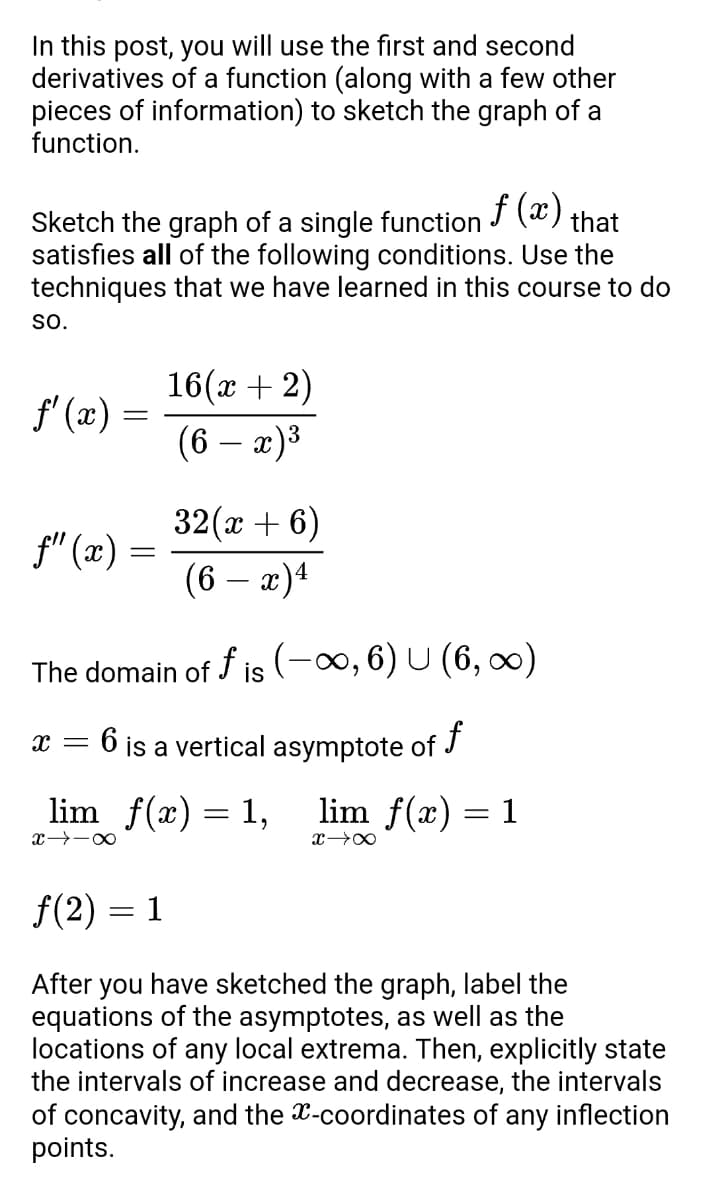In this post, you will use the first and second derivatives of a function (along with a few other pieces of information) to sketch the graph of a function. f(x) that Sketch the graph of a single function satisfies all of the following conditions. Use the techniques that we have learned in this course to do SO. 16(x + 2) f'(x) = (6 − x)³ 32(x + 6) f"(x) = (6 - x) 4 The domain of f is (-∞, 6) U (6, ∞) X = 6 is a vertical asymptote of f lim_ f(x) = 1, lim f(x) = 1 x118 x →∞ f(2)= 1 After you have sketched the graph, label the equations of the asymptotes, as well as the locations of any local extrema. Then, explicitly state the intervals of increase and decrease, the intervals of concavity, and the x-coordinates of any inflection points.
In this post, you will use the first and second derivatives of a function (along with a few other pieces of information) to sketch the graph of a function. f(x) that Sketch the graph of a single function satisfies all of the following conditions. Use the techniques that we have learned in this course to do SO. 16(x + 2) f'(x) = (6 − x)³ 32(x + 6) f"(x) = (6 - x) 4 The domain of f is (-∞, 6) U (6, ∞) X = 6 is a vertical asymptote of f lim_ f(x) = 1, lim f(x) = 1 x118 x →∞ f(2)= 1 After you have sketched the graph, label the equations of the asymptotes, as well as the locations of any local extrema. Then, explicitly state the intervals of increase and decrease, the intervals of concavity, and the x-coordinates of any inflection points.
Chapter3: Functions
Section3.2: Domain And Range
Problem 61SE: The cost in dollars of making x items is given by the function Cx)=10x+500. a. The fixed cost is...
Related questions
Question
Please provide and explanation beside the solution.
Thank you!

Transcribed Image Text:In this post, you will use the first and second
derivatives of a function (along with a few other
pieces of information) to sketch the graph of a
function.
f(x)
that
Sketch the graph of a single function
satisfies all of the following conditions. Use the
techniques that we have learned in this course to do
SO.
16(x + 2)
f'(x) =
(6 − x)³
f" (x) =
32(x + 6)
(6 - x) 4
The domain of fis (-∞, 6) U (6, ∞)
X
6 is a vertical asymptote of f
=
lim_ƒ(x) = 1,
lim f(x) = 1
x18
x →∞
f(2)= 1
After you have sketched the graph, label the
equations of the asymptotes, as well as the
locations of any local extrema. Then, explicitly state
the intervals of increase and decrease, the intervals
of concavity, and the x-coordinates of any inflection
points.
Expert Solution
This question has been solved!
Explore an expertly crafted, step-by-step solution for a thorough understanding of key concepts.
This is a popular solution!
Trending now
This is a popular solution!
Step by step
Solved in 2 steps with 2 images

Recommended textbooks for you


Functions and Change: A Modeling Approach to Coll…
Algebra
ISBN:
9781337111348
Author:
Bruce Crauder, Benny Evans, Alan Noell
Publisher:
Cengage Learning

College Algebra
Algebra
ISBN:
9781305115545
Author:
James Stewart, Lothar Redlin, Saleem Watson
Publisher:
Cengage Learning


Functions and Change: A Modeling Approach to Coll…
Algebra
ISBN:
9781337111348
Author:
Bruce Crauder, Benny Evans, Alan Noell
Publisher:
Cengage Learning

College Algebra
Algebra
ISBN:
9781305115545
Author:
James Stewart, Lothar Redlin, Saleem Watson
Publisher:
Cengage Learning

Big Ideas Math A Bridge To Success Algebra 1: Stu…
Algebra
ISBN:
9781680331141
Author:
HOUGHTON MIFFLIN HARCOURT
Publisher:
Houghton Mifflin Harcourt

Algebra & Trigonometry with Analytic Geometry
Algebra
ISBN:
9781133382119
Author:
Swokowski
Publisher:
Cengage

Trigonometry (MindTap Course List)
Trigonometry
ISBN:
9781337278461
Author:
Ron Larson
Publisher:
Cengage Learning